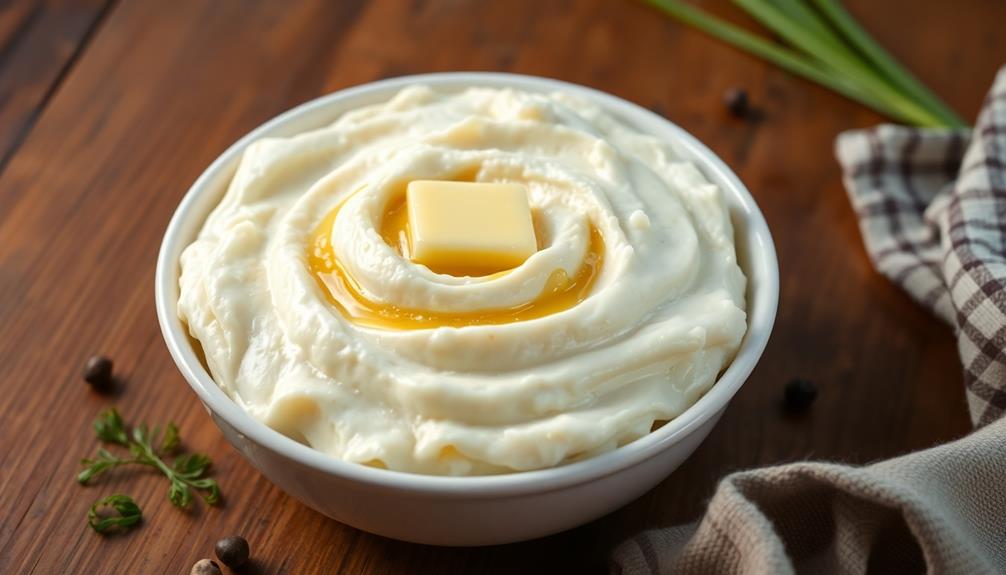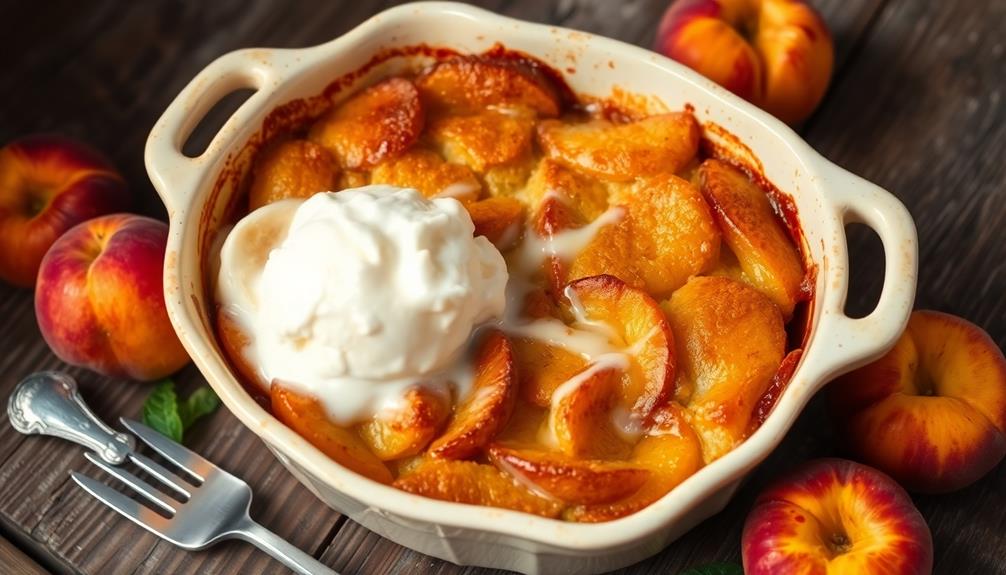Mashed potatoes are a comforting side dish with a rich history dating back to 18th-century France. You'll love their creamy texture and versatility. To make them, start by peeling and cutting potatoes into even chunks. Boil until tender, then drain and mash with butter and milk. The key to perfect mashed potatoes lies in the technique and ingredients you choose. You can customize them with add-ins like garlic, herbs, or cheese. They're ideal for holiday dinners, weeknight meals, or any occasion that calls for a warm, satisfying dish. There's so much more to explore about this beloved comfort food.
Key Takeaways
- Mashed potatoes are a versatile comfort food made from boiled potatoes, butter, milk, and seasonings.
- Key ingredients include Russet or Yukon Gold potatoes, unsalted butter, milk or cream, salt, and pepper.
- The cooking process involves peeling, cutting, boiling, draining, and mashing potatoes before adding butter and milk.
- Proper technique is crucial for achieving creamy texture; avoid over-mashing to prevent gluey consistency.
- Mashed potatoes can be customized with various add-ins like garlic, herbs, cheese, or alternative milk options.
History
Humble and comforting, mashed potatoes have a long and varied history. You might be surprised to learn that this beloved dish dates back to 1771 when it first appeared in a French cookbook. However, potatoes themselves have been a staple food for thousands of years, originating in South America.
As potatoes spread across Europe in the 16th century, they quickly became a popular crop due to their hardiness and nutritional value. You'll find that mashed potatoes gained prominence during times of economic hardship, as they were an affordable and filling option for many families.
In the United States, you can trace the popularity of mashed potatoes to the 1920s, when they became a common side dish in restaurants and homes alike. During World War II, you'd have seen mashed potatoes featured in military rations, further cementing their place in American cuisine.
Today, you'll find countless variations of this classic dish, from garlic-infused versions to those incorporating different root vegetables. Whether you prefer them creamy or chunky, mashed potatoes continue to be a beloved comfort food around the world.
Recipe
Mashed potatoes are a beloved comfort food and a staple side dish in many cuisines around the world. This creamy and versatile dish is perfect for holiday dinners, weeknight meals, or any occasion that calls for a warm and satisfying accompaniment.
Creating the perfect mashed potatoes is an art that combines simple ingredients with careful technique. The key to achieving a smooth and fluffy texture lies in selecting the right type of potatoes and preparing them properly. This recipe will guide you through the process of making classic mashed potatoes that are sure to please even the most discerning palates.
Ingredients:
- 2 pounds Russet or Yukon Gold potatoes
- 1/2 cup unsalted butter
- 1/2 cup milk or cream
- Salt to taste
- Black pepper to taste
- Optional: chopped chives or garlic for added flavor
Begin by peeling and cutting the potatoes into evenly sized chunks. Place them in a large pot and cover with cold water. Add a pinch of salt and bring to a boil. Reduce heat and simmer for 15-20 minutes or until potatoes are tender when pierced with a fork.
Drain the potatoes and return them to the pot. Add butter and milk, then mash using a potato masher or ricer until desired consistency is reached. Season with salt and pepper to taste, and stir in any optional ingredients if desired.
For the best results, avoid overmixing the potatoes as this can lead to a gluey texture. If you prefer a smoother consistency, use a ricer instead of a masher. Warming the milk and butter before adding them to the potatoes can help maintain a hotter serving temperature.
Experiment with different add-ins like roasted garlic, herbs, or cheese to create your own unique variations on this classic dish. You could try adding roasted garlic for a savory twist, or fresh herbs like thyme or rosemary for a burst of flavor. If you’re feeling adventurous, you can even stir in some shredded cheese for a gooey, indulgent finish. The possibilities are endless when it comes to customizing this creamy onion recipe to suit your personal tastes and preferences. With a little creativity and experimentation, you can elevate this simple dish into something truly special.
Cooking Steps
To create perfect mashed potatoes, you'll need to follow a few essential steps.
Start by peeling and cutting your potatoes, then boil them until they're tender enough to easily pierce with a fork.
Once cooked, drain the water from the pot, mash the potatoes with a masher or ricer, and finally add butter and milk to achieve your desired consistency and flavor.
Step 1. Peel and Cut Potatoes

Before diving into the cooking process, you'll need to prepare your potatoes. Start by selecting the right type of potato for mashing. Starchy varieties like Russets or Yukon Golds work best, as they'll give you that creamy texture you're after.
Next, it's time to peel and cut your potatoes. Here's what you'll need to do:
- Rinse the potatoes under cool water to remove any dirt or debris.
- Use a vegetable peeler to remove the skin, working from one end to the other.
- For stubborn spots, use a paring knife to carefully remove any remaining peel or blemishes.
Once peeled, cut the potatoes into evenly sized chunks, about 1-2 inches in size.
Cutting your potatoes into uniform pieces is crucial for even cooking. If they're too large or uneven, you'll end up with some overcooked and some undercooked pieces.
Remember, the smaller you cut them, the faster they'll cook. However, don't go too small, or you'll risk them becoming waterlogged during boiling.
With your potatoes prepped, you're ready to move on to the next step in creating perfect mashed potatoes.
Step 2. Boil Potatoes Until Tender

Now that your potatoes are peeled and cut, it's time to cook them until they're tender. Place the potato pieces in a large pot and cover them with cold water, making sure there's about an inch of water above the potatoes. Add a pinch of salt to the water, which will enhance the flavor of your mashed potatoes later.
Next, place the pot on the stove and turn the heat to high. Once the water starts boiling, reduce the heat to medium-low and let the potatoes simmer. Cooking time will vary depending on the size of your potato pieces, but it typically takes 15-20 minutes.
To check if your potatoes are done:
- Pierce a potato piece with a fork or knife
- If it slides in easily with little resistance, they're ready
- If there's still some firmness, continue cooking and check every few minutes
Once tender, drain the potatoes in a colander. Be careful with the hot water! Let them steam dry for a minute or two before moving on to the next step in your mashed potato journey.
Step 3. Drain Water From Pot

The moment of truth has arrived for your tender potatoes. It's time to drain the water from the pot, a crucial step in creating the perfect mashed potatoes. Here's how to do it:
- Carefully approach the pot of boiling potatoes, wearing oven mitts to protect your hands.
- Place a colander in the sink to catch the potatoes.
- Slowly tilt the pot over the colander, allowing the hot water to drain away.
- Gently shake the pot to ensure all water is removed.
As you drain the potatoes, you'll notice steam rising from the colander. This is normal and indicates that your potatoes are still hot and ready for the next step. Be cautious, as the steam can cause burns if you're not careful.
Why is draining important? Excess water can make your mashed potatoes too watery and dilute their flavor. By removing all the cooking water, you're ensuring that your potatoes will have the perfect consistency and taste.
Once drained, you're ready to return the potatoes to the pot for mashing. Remember, timing is key – don't let your potatoes cool too much before mashing!
Step 4. Mash Potatoes With Masher

With your drained potatoes back in the pot, it's time to transform them into creamy goodness. Grab your potato masher and get ready to put some elbow grease into the process.
Here's how to mash your potatoes to perfection:
- Start by gently pressing the masher into the potatoes, using a downward motion.
- Work your way around the pot, ensuring you're reaching all the potatoes.
- Continue mashing until you've broken down most of the larger chunks.
- For smoother potatoes, keep mashing until you reach your desired consistency.
As you're mashing, you'll notice the potatoes becoming creamier. This process releases the starch in the potatoes, which contributes to their smooth texture.
If you encounter any stubborn lumps, focus on those areas with extra attention.
Step 5. Add Butter and Milk

After mashing, it's time to add richness and creaminess to your potatoes. You'll want to incorporate butter and milk to achieve that classic, velvety texture.
Start by adding about 1/4 cup of butter per pound of potatoes. Make sure the butter is at room temperature, as it'll blend more easily. Cut it into small pieces and drop them onto the hot potatoes, letting them melt for a minute.
Next, pour in warm milk gradually. Begin with about 1/4 cup per pound of potatoes, but remember that you can always add more if needed. Warm milk incorporates better and helps maintain the potatoes' temperature.
As you add the milk, use a wooden spoon or rubber spatula to fold everything together gently. This method preserves the potato's structure better than vigorous stirring.
Keep folding until you've reached your desired consistency. If you prefer creamier potatoes, add more milk in small increments. For richer flavor, you can substitute some or all of the milk with heavy cream.
Final Thoughts
In light of all we've covered, mashed potatoes remain a beloved comfort food for good reason.
They're versatile, comforting, and can be customized to suit various tastes and dietary needs. As you perfect your mashed potato technique, remember that practice makes perfect. Don't be afraid to experiment with different potato varieties, add-ins, and seasonings to find your ideal combination.
When you're serving mashed potatoes, consider these final tips:
- Reheat leftovers gently, adding a splash of milk or cream to restore moisture.
- For a smoother texture, use a food mill or ricer instead of a masher.
- Try mixing in roasted garlic, herbs, or cheese for extra flavor.
- If you're watching calories, use chicken broth instead of milk and butter.
Frequently Asked Questions
Can Mashed Potatoes Be Made Ahead of Time and Reheated?
Yes, you can definitely make mashed potatoes ahead of time and reheat them! It's a great way to save time when preparing meals.
Here's how you can do it:
- Prepare your mashed potatoes as usual
- Let them cool completely
- Store in an airtight container in the fridge (up to 3 days)
- When ready to serve, reheat in the microwave or oven
- Add a splash of milk or cream while reheating to maintain creaminess
What's the Best Potato Variety for Making Mashed Potatoes?
You'll find that russet potatoes are often considered the best variety for making mashed potatoes. They're high in starch and low in moisture, which gives you a fluffy, creamy result.
However, don't overlook Yukon Gold potatoes; they've got a naturally buttery flavor and creamy texture that many people love.
If you're feeling adventurous, you can even try a mix of both varieties.
Whichever you choose, make sure to avoid waxy potatoes like red or new potatoes for the best mashed potato experience.
How Long Can Mashed Potatoes Be Safely Left at Room Temperature?
You'll want to be cautious with leaving mashed potatoes at room temperature.
For food safety, don't keep them out for more than two hours. Bacteria can grow rapidly between 40°F and 140°F, which is known as the "danger zone."
If your room is particularly warm (above 90°F), that time reduces to just one hour.
To keep your mashed potatoes safe, refrigerate them promptly after serving or keep them hot (above 140°F) if you're planning to serve them later.
Are There Any Dairy-Free Alternatives for Making Creamy Mashed Potatoes?
Yes, there are several delicious dairy-free alternatives for creamy mashed potatoes! You can try:
- Plant-based milks like almond, oat, or coconut milk
- Vegan butter or margarine
- Olive oil or avocado for a healthy fat option
- Vegetable broth for added flavor
- Nutritional yeast for a cheesy taste
When using these alternatives, you'll want to adjust the amount to achieve your desired consistency.
Don't forget to season well with salt, pepper, and herbs for maximum flavor.
Experiment to find your perfect combination!
Can You Freeze Mashed Potatoes, and How Long Do They Last Frozen?
Yes, you can freeze mashed potatoes! They'll last up to 6 months in the freezer when stored properly.
Here's what you need to do:
- Let them cool completely
- Portion into airtight containers or freezer bags
- Remove as much air as possible
- Label with the date
When you're ready to eat them, thaw overnight in the fridge.
Reheat gently on the stove or in the microwave, adding a splash of milk or butter if needed to restore creaminess.
Enjoy your homemade, ready-to-eat mashed potatoes anytime!










